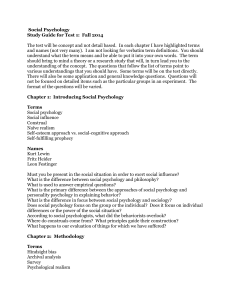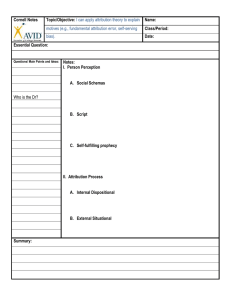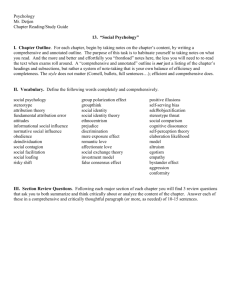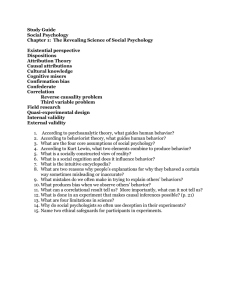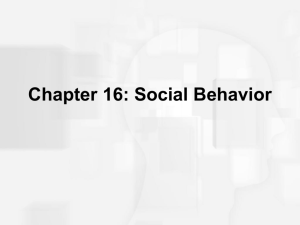DOC - Commonwealth Association for Education Administrator
advertisement
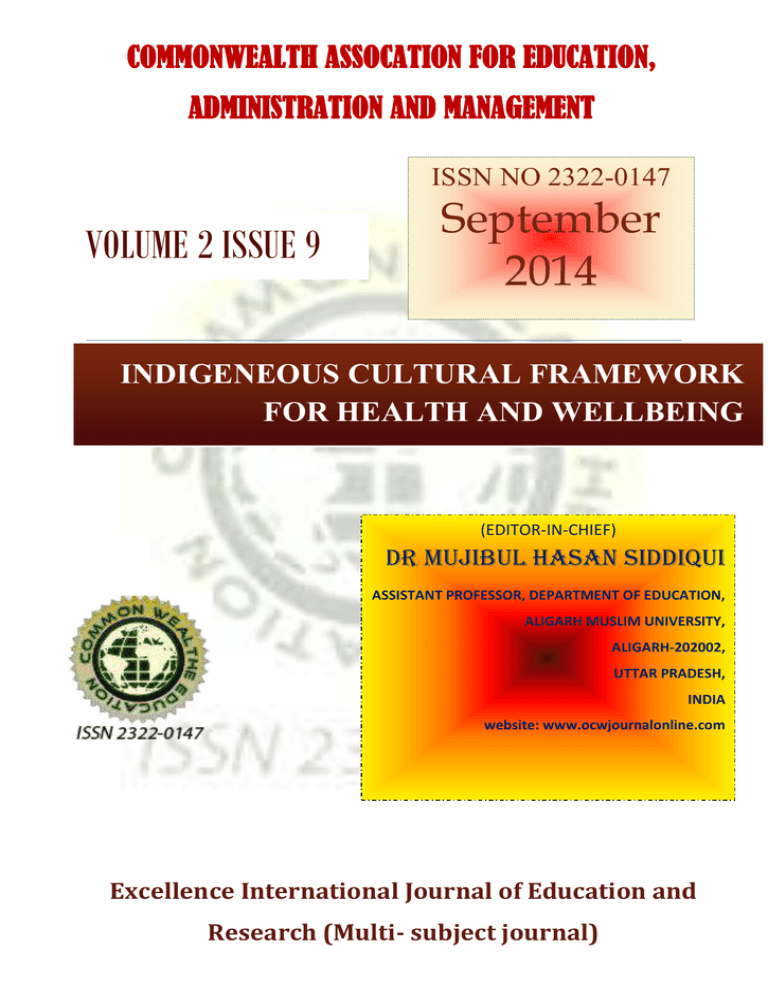
COMMONWEALTH ASSOCATION FOR EDUCATION, ADMINISTRATION AND MANAGEMENT ISSN NO 2322-0147 VOLUME 2 ISSUE 9 September 2014 INDIGENEOUS CULTURAL FRAMEWORK FOR HEALTH AND WELLBEING (EDITOR-IN-CHIEF) DR MUJIBUL HASAN SIDDIQUI ASSISTANT PROFESSOR, DEPARTMENT OF EDUCATION, ALIGARH MUSLIM UNIVERSITY, ALIGARH-202002, UTTAR PRADESH, INDIA website: www.ocwjournalonline.com Excellence International Journal of Education and Research (Multi- subject journal) Excellence International Journal Of Education And Research VOLUME 2 ISSUE 9 ISSN 2322-0147 INDIGENEOUS CULTURAL FRAMEWORK FOR HEALTH AND WELLBEING By Naghmajaved Research scholar Lucknow university Lucknow Naghmajavedmidhat@gmail.com Health refers to the full and harmonious functioning of the total personality, which implies the presence of positive health i.e. physical, psychological, social and spiritual well being; and the absence of negative health i.e. the absence of ill health. Health systems and practices in all societies are based on certain shared beliefs about the world, self and human existence. These cultural beliefs provide the necessary framework for defining health, understanding the causes of illness, and deciding the mode of treatment ( Dalal and Singh, 2001) health in this sense is considered to be integral to the general wellbeing of the person, where no clear cut distinctions are made between physical, spiritual and mental health. The Indian Concept of Health and Healing Sinha (1990) examined ancient Indian scriptures and noted that the Indian conceptualization of health is broad based and affirmative. He quoted Sushrut, the ancient proponent of the traditional system of medicine and surgery, who has defined health as a state of delight or a feeling of spiritual, physical and mental well being. In the CharakSamhita, the ancient work on the Indian work of medicine, the characteristics of happy and unhappy life has been elaborated, “life is said to be happy if the person if the person is not afflicted with any somatic and psychic disorder….has achieved desired results of all actions and moves about where he likes; contrary to it is unhappy life.” According to Sankhya, our life on this earth is a mixture of joys and sorrow, pleasures and pain. There are three kinds of pain that goes against our well being i.e. the ahdyatmika, adhibhautika and adhidaivika. Disagreements about the meaning of health are common because health can have medical, social, cultural, economic spiritual and many other components. Dubos (1961) identifies the complex nature of health when he compared our perception of health to a “receding mirage”. From distance health appears to be a clear concept but as we approach and attempt to define it, the substance disappears. It goes well with the notion of human existence in terms of five sheaths (koshas). A related aspect is the emphasis on balance (sama) or equilibrium. Health is like a dynamic field in which different elements operate in communion and harmony.The concern is not with cure i.e., treating and preventing organic malfunctioning, but with healing the person, i.e., regenerating a sense of well-being and fitness to deal with one’s life conditions. In the backdrop of this expanded definition of health and wellbeing. The terms health and well-being are often used interchangeably. Well-being comprises people’s evaluations, both affective and cognitive of their lives (Diener&Suh, Excellence International Journal Of Education And Research (Multi-subject journal) Page 237 Excellence International Journal Of Education And Research VOLUME 2 ISSUE 9 ISSN 2322-0147 1997). It is an outcome of a complex array of biological, socio-cultural, psychological, economic and spiritual factors. Analyzing the discourse on health Nandy (2000) calls for attending to the plurality of the notion of health and emphasizes on the need to bring to our psychological inquiry “something of the sagacity, insights and cumulative wisdom of the people with whom we live”. The conceptualization of the state of well-being is closer to the concept of mental health and happiness, life satisfaction and actualization of one’s full potential. Verma and Verma (1989) have defined general well-being as the subjective feeling of contentment, happiness, satisfaction with life’s experiences and of one’s role in the world of work, sense of achievement, utility, belongingness, and no distress, dissatisfaction or worry, etc. Health belief is an individual’s own ideas about health and illness, which a person holds and these beliefs place a significant role in shaping health practices. It is recognized that the patient’s own beliefs about their health and treatment regulate their health behavior to a far greater extent than the doctor’s belief or objective medical data (Roberts et al, 1984). Health beliefs can develop through experiences from seeing friends or family and information acquired through the media. A belief system arises as a response to environment and social conditions. All these information are organized into belief system that can be large as a whole cluster or as small as a cluster of attitude (Frizda, Manstead&Bem, 2000). Belief about health and illness are both individual as well as social (Herzlich, 1973) and are also influenced by prevailing social and medical ideologies. Health beliefs are important as they form the basis for deciding which strategies and behavior patients will develop (Leventhal, Mayer &Neerenze, 1980) the history of preventive care observed that a belief system prevails in cultures which inhibit or encourage people to accept or reject a welfare program even if it is medically proved successful (D. Sinha, 1999). These beliefs are preserved as traditions in cultures. Health beliefs may have several aspects like the conceptualization of health, causation for illness or good health, importance of health, health practices, coping strategies and so on. When diagnosed with a condition people soon develop belief about the symptoms caused by the illness. These ideas play a significant role in treatment (Weinman, Petrie, Sharp and Walker, 2000). In other words illness caused beliefs can strongly influence the emotional response to illness, particularly if the patient blames him or herself for the illness. In this situation, patient adjusts in a good manner. On the other hand there is some evidence to show that when the patient blames other for their illness this may result in a worse adjustment to illness particularly due to unresolved hostility. (Taylor, Lichtman& Wood, 1984).Whether causal search is present or absent, the evidence is overwhelming that the patient who have causal explanations are better adjusted than those who have no causal explanation (Bulman&Wortman, 1980). People who believe that it is possible to control their health problems seems better adjusted (Helegeson, 1992) more likely to attend rehabilitation programs. The vision of health evolved in India are centered on harmony, evolution and connection of life with ecology in which a person or group is embedded. It is bold and broad enough to incorporate the whole range of existential concerns right from the Sharira (body) to Atman (self). TheUpnishadic notion of PanchaKoshasdepicts and conceptualizes human existence as multi layered entity. In this scheme the idea of being is very inclusive. It is not merely a Excellence International Journal Of Education And Research (Multi-subject journal) Page 238 Excellence International Journal Of Education And Research VOLUME 2 ISSUE 9 ISSN 2322-0147 reactive organism responding mechanically to the incoming stimuli. It is a conscious being living a self-regulated life that works on the principles of complementarity, interdependence, sharing and reciprocity. The Indian view which is primarily universal has space to accommodate diversities. It tries to locate a person’s existence in the state of dynamic reality. The Samsar (world) is full of bhavabadha(obstacles) and which certainly has enough degrees of dukha and tap (suffering). The world has all these problems and there is no denial of this fact. sukha and dukha (Pleasure and pain) both are equally important parts of worldly life. But the self conceived as witness has to situate himself or herself as a mere sakshi(witness) and maintain equal distance with both. The notion of sthitapragya-a wise man, according to Bhagvadgita, implies that one has to consider positive and negative states both as similar (same kritva). Human beings are conceived to have happiness or bliss as their inherent quality. The assumption that happiness and well-being are intrinsic properties of one’s self are important implications of health. It is our Avidya (ignorance) that makes us deprived of realizing our blissful true nature and puts us in a state when one remains perturbed, sick or ill. Being healthy or non-healthy is contingent on where you are located. The way one is positioned and the stance that one takes in viewing the world and self decides how do we feel. In this context the Indian notion of a healthy person as one who is Swastha (auto locus) is very meaningful. The desire for the well-being of everyone who so ever is suffering (kamayedukhtaptanampraninamartinshanam) has been a core Indian concern that has pan human relevance. In this process search for true self in terms of expanding boundaries of one’s existence underlines the value of connectivity. Ayurveda, the Indian science of life, recognizes the life forms derived from the material reality( panchmahabhutas: earth, water, fire, air and space)and therefore offers remedies for being healthy by opening dialogue with environment recognition of order (dharma)in the entire life world (shristi). Health and well-being are simultaneously personal and social and the Indian perspective is often considered as spiritual. Ayurveda maintains two fold goals i.e. preservation and promotion of health(swasthyaswastharakshanam) and prevention and management of disease (vicar prashamanam). Thus it attends to the need and requirements of the presently healthy people and takes care of those which are suffering from diseases. Health (Arogya) is necessary form pursuing life goals (purusharthas). Human body is an instrument pursuing dharma. Shusrata has discussed the meaning of auto locus. Understanding Diseases: In Ayurvedic usage the etiological analysis and diagnosis go hand in hand. Both are termed as Nidan. In this process a variety of sources of relevant knowledge are used. They include knowledge based of the advice of knowledgeable people (aptopadesha), immediate perception (pratyaksha) and inference ( Anuman). The analysis includes determining the cause (hetu), nature (ling) and medicine (aushadhi). Similiarly the physician has to determine the earlier form (purvarupa), subsequent form (upshaya) and prognosis (Anushaya). The internal causes like pitta and kapha and external influences leading to disease include environment, luck (daiva and karma). Excellence International Journal Of Education And Research (Multi-subject journal) Page 239 Excellence International Journal Of Education And Research VOLUME 2 ISSUE 9 ISSN 2322-0147 Treatment: Ayurveda system operates with a model that treats each individual as a unique make up of the three doshas. When any of these three doshas, vata, pitta and kapha becomes accumulated, Ayurveda will suggest specific lifestyle and nutritional guidelines to assist the individual in reducing the doshas that has become excessive. Once the body is sound and the mind is balanced the dynamic process of well being shall continue towards ‘self realization’ through spiritual endeavors. The Western Approach towards Health And Well-Being The western approach towards the concept of health and health belief; makes it an encompassing question, which they tried to answer as an attribute of mind. Attribution theory is concerned with how individuals interpret events and this relates to their thinking and behavior. Psychological research into attribution began with the work of Fritz Heider during the early years of the 20th century. In his 1920's dissertation Heider addressed a fundamental problem of phenomenology; why do perceivers attribute the properties of an object they sense, such as its color, texture and so on, to the object itself when those properties exist only in their minds? Heider's answer was to consider the object being perceived and the physical media by which it is sensed – the ticking of a watch causing vibrations in the air for instance – to be quite distinct, and that what the perceiver's senses do is to reconstruct an object from its effect on the media, a process he called attribution. "Perceivers faced with sensory data thus see the perceptual object as 'out there', because they attribute the sensory data to their underlying causes in the world." Heider subsequently extended his ideas to the question of how people perceive each other, and in particular how they account for each other's behavior, person perception. Motives played an important role in Heider's model: "motives, intentions, sentiments ... the core processes which manifest themselves in overt behavior". Heider distinguished between personal causality – such as offering someone a drink – and impersonal causality such as sneezing, or leaves falling. Later attribution theorists have tended to see Heider's fundamental distinction as being between person (or internal) causes and situation (or external) causes of behavior. Later on Weiner and colleagues (Jones et.al .1972; Weiner,1974,1986) developed a theoretical frame work that has become a major research paradigm of social psychology. Attribution theory assumes that people try to determine why people do they do, i.e. attribute causes to behaviour Causation is central to all the discussions. Questions rose by philosophers, scientists and historians, in relation to causation are logical; they are not the same as a common man’s causation or what is generally termed as ‘common sense’. The concern of social scientist is that why these beliefs are important and how they are arrived at. The causal explanation of a common man has been central to the attribution theory. Much discussion is centered on; whether attributions are always explanations and whether explanations are always causal. The debate continued over whether people in effect answered the question why? Or ‘for what reason?’and if the explanation is causal. The research in the area demonstrate the interest of the social psychologists in common-sense-explanation, or in how and why ordinary people explains events. A three stage process underlies an attribution: 1). The person perceives or observe the behavior Excellence International Journal Of Education And Research (Multi-subject journal) Page 240 Excellence International Journal Of Education And Research VOLUME 2 ISSUE 9 ISSN 2322-0147 2). Then the person must believe that the behavior was intentionally performed 3). Then the person must determine if the other person was forced to perform that (in this case the cause is attributed to their situation) or not (in which the cause is attributed to the other person) The Defensive Attribution Hypothesis (or defensive attribution bias) is a social psychological term referring to a set of beliefs held by an individual with the function of defending the individual from concern that they will be the cause or victim of a mishap. Commonly, defensive attributions are made when individuals witness or learn of a mishap happening to another person. In these situations, attributions of responsibility to the victim or harm-doer for the mishap will depend upon the severity of the outcomes of the mishap and the level of personal and situational similarity between the individual and victim. More responsibility will be attributed to the harm-doer as the outcome becomes more severe, and as personal or situational similarity decreases. Learned helplessness was first found in animals when psychologists Martin Seligman and Steven F. Maier discovered that the classically conditioned dogs that got electrical shocks made no attempt to escape the situation. The dogs were placed in a box divided into two sections by a low barrier. Since one side of the box was electrified and the other was not, the dogs could easily avoid electrical shocks by hopping to the other side. However, the dogs just stayed in the electrified side, helpless to change the situation. This learned helplessness also applies to human beings. People feel helpless when they feel powerless to change their situation. This happens when people attribute negative results to their internal, stable and global factors leading them to think they have no control over their situation. Making no attempt to avoid or better the situation will often exacerbate the situations that people are faced with, and may lead to clinical depression and related mental illnesses. When people try to make attributions about another's behavior, their information focuses on the individual. Their perception of that individual is lacking most of the external factors which might affect the individual. The gaps tend to be skipped over and the attribution is made based on the perception information most salient. The most salient perceptual information dominates a person's perception of the situation.For individuals making behavioral attributions about themselves, the situation and external environment are entirely salient, but their own body and behavior are less so. This leads to the tendency to make an external attribution in regards to their own behavior. From the book The Psychology of Interpersonal Relations(1958), Fritz Heider tried to explore the nature of interpersonal relationship, and espoused the concept of what he called "common sense" or "naïve psychology". In his theory, he believed that people observe, analyze, and explain behaviors with explanations. Although people have different kinds of explanations for the events of human behaviors, Heider found it is very useful to group explanation into two categories; Internal (personal) and external (situational) attributions. When an internal attribution is made, the cause of the given behavior is assigned to the individual's characteristics such as ability, personality, mood, efforts, attitudes, or disposition. When an external attribution is made, the cause of the given behavior is assigned Excellence International Journal Of Education And Research (Multi-subject journal) Page 241 Excellence International Journal Of Education And Research VOLUME 2 ISSUE 9 ISSN 2322-0147 to the situation in which the behavior was seen such as the task, other people, or luck (that the individual producing the behavior did so because of the surrounding environment or the social situation). These two types lead to very different perceptions of the individual engaging in a behavior. Weiner focused his attribution theory on achievement, identified ability, effort, task difficulty and luck as the most important factor affecting the attribution for achievement. Attributions are classified along the causal dimensions: locus of control, stability and controllability. The locus of control dimension has two poles: internal vs. external locus of control. The stability dimension captures whether causes change over time or not. For instance, ability can be classified as a stable, internal cause and motivation as unstable and internal. Controllability contrasts causes on control such as skill/efficacy, from causes one cannot control such as aptitude, mood, other’s action and luck. Weiner’s theory has been widely applied in education, law, clinical psychology and the mental health domain. The belief and the attribution that people hold can influence their health by affecting their bahaviour like how they respond to attending various test schedule, food they eat and whether they take prescribed medicines or more directly by affecting a physiological system such as immune or cardiovascular system. These two modes of influence are not mutually exclusive. While there is general agreement among the psychologists that health beliefs and attribution are important in explaining and predicting health behavior and health outcomes, there is less agreement about which attributions and beliefs are important. References: Bulman, R.J. &Wortman, C.B. (1977). Attributions of blame and coping in the “real world”: Sever accident victims react to their lot. Journal of Personality and Social Psychology, 35, 351-363. Dalal and Singh, 2001Dalal, A.K. (2000). Living with a chronic disease: Healing and psychological adjustment in Indian society. Psychology and Developing Societies,12, Heider, F. (1958). The Psychology of Interpersonal Relations. New York: Wiley. Jones, E. E., D. E. Kannouse, Helgeson, V.S. (1992). Moderators of the relation between perceived control and adjustment to chronic illness.Journal of Personality and Social Psychology, 63(4), 656-666 Janoff-Bulman R. (1989). Assumptive worlds and the stress of traumatic events: Applications of the schema construct. Soc Cognition; 7:113–136. Leventhal. H.. Meyer, D. &Nerenz, DR. (1980). The common sense representation of illness danger. In .S. Rachman (Ed.). Contributions to Medical Psychology(vol. 2, pp.7-30). New York Pergamon Press. 189- 203). Amsterdam: North Holland, Elsevier Science. Roberts, C. S., Rossetti, K., Cone, D., and Cavanagh, D. (1992). Psychological impact of gynaecological cancer: A descriptive study. Journal of Psychosocial Oncology. Taylor SE. (1983). Adjustment to threatening events: A theory of cognitive adaptation. American Psychologist; 38:1161–1173. Taylor, S.E., Lichtman, R.R. & Wood, J.V. (1984). Attributions, beliefs about control, and adjustment to breast cancer. Journal of Personality and Social Psychology, 46, 489-502. Weiner, B. (1974). Achievement motivation and attribution theory. Morristown, N.J.: General Learning Press. Weinman, J., Petrie, K. J., Sharpe, N. and Walker, S. (2000), Causal attributions in patients and spouses following first-time myocardial infarction and subsequent lifestyle changes. British Journal of Health Psychology, 5: 263–273. Excellence International Journal Of Education And Research (Multi-subject journal) Page 242

